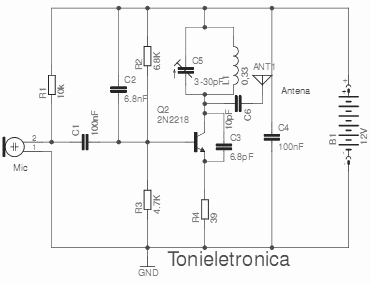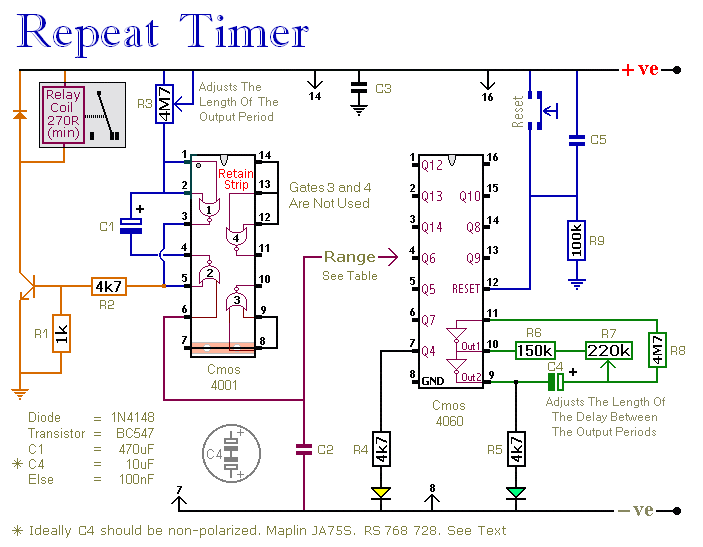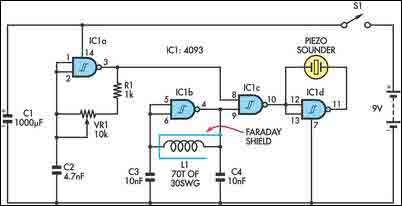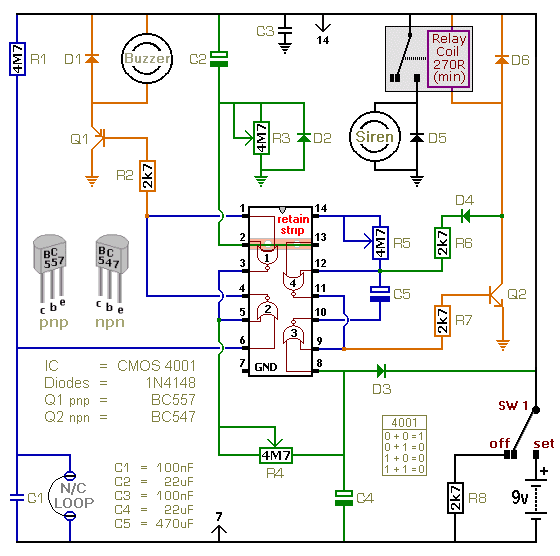
latest touch alarm system circuit
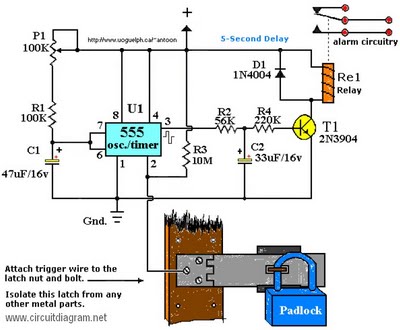
The operating voltage for capacitors C1 and C2 should be raised to 25V if a 12V energy source is used. A general guideline is that the operating voltage of capacitors should be at least double the supplied voltage; for instance, if the power source is 9V, the capacitor(s) should have a minimum rating of 18V. Transistor T1 can be substituted with any suitable equivalent. Any appropriate relay may be utilized for the project, and size is flexible if space is not a constraint. This circuit was developed to deter students from tampering with security cameras in university PC labs. It is important to ensure that the metal casing is not grounded. The schematic allows for connection to any type of metal surface. A 12V DC power adapter is recommended. The relay selected should meet the project's requirements. A normally closed RESET switch can be added between the constructive and the positive terminal. The trigger wire is connected to pin 2 of the 555 timer and will activate the relay using body resistance when touched. It is essential that the touching component is clean and makes good contact with the trigger wire. This circuit may not be suitable for all applications. Note that pin 5 is not included in the schematic as it is not strictly necessary; however, in noisy environments, a small ceramic capacitor can be connected between pin 5 and ground to filter noise, although it is optional. Additionally, there is an approximate 5-second delay built into the circuit before relay activation to prevent false triggering or detection of potential intruders.
The circuit described utilizes a 555 timer integrated circuit configured in monostable mode to create a touch-sensitive relay activation system. The 555 timer is powered by a 12V DC power adapter, ensuring that the voltage levels are compatible with standard electronic components. The choice of a relay is flexible, allowing for various types to be used based on the specific requirements of the application, such as current rating and switching capacity.
Capacitors C1 and C2 are critical for stabilizing the voltage and ensuring reliable operation. Their voltage ratings must be appropriately selected to handle the maximum expected voltage, which, in this case, is at least 25V to accommodate the 12V power supply. The selection of a transistor for T1 can be made from a range of NPN or PNP transistors that can handle the relay's coil current.
The RESET switch, typically a normally closed type, provides a manual method to reset the system, ensuring that the relay can be deactivated when needed. The touch-sensitive trigger wire connected to pin 2 of the 555 timer is designed to detect changes in resistance when a user touches it, thus triggering the relay. The design emphasizes the importance of maintaining a clean contact surface for reliable operation.
In terms of layout, the circuit should be arranged to minimize noise interference, particularly in environments where electrical noise may be present. The optional capacitor between pin 5 and ground can help filter out any high-frequency noise that could affect the stability of the timer. The built-in delay mechanism is an important feature that prevents unintentional activation of the relay, providing a buffer period that can differentiate between accidental touches and intentional activation.
Overall, this circuit serves a practical purpose in security applications, particularly in educational environments, by providing a deterrent against tampering with sensitive equipment.C1/C2 operating voltage should be elevated to 25V if you decide to go with a 12V energy source. Rule of thumb: the operating voltage of capacitors are at least double the supplied voltage, in other words, if the powersource is 9Volt, your capacitor(s) is a minimum of 18V. Transistor T1 could be any approximate substitute. * Use any suitable r elay for the project and if you are not tight on area, use any size. I`ve develop this specific circuit to prevent students from fiddling using the security cameras in pc labs in the University I`m employed. I made certain the metal casing was not grounded. But as the schematic shows you can essentially hook it as much as any type of metal surface. I utilized a 12-vdc power adapter. Use any appropriate relay to handle your requirements. A RESET` switch (Usually Closed) can be added between the constructive and the arrow-with-the-+`. The trigger (touch) wire is connected to pin 2 of the 555 and will trigger the relay, utilizing the body resistance, when touched.
It is apparent that the touching` component has to be clean and can make good get in touch with with the trigger wire. This particular circuit may not be suitable for all applications. Just in case you wonder why pin 5 isn`t listed within the schematic diagram; it isn`t truly required.
In certain noisy conditions a little ceramic capacitor is placed in between pin 5 and ground. It does no harm to add one or leave it out. Extra note: For all those of you who didn`t discover, there is an approximate 5-second delay build-in prior to activation of the relay to avoid false triggering, or a would-be` thief, etc. 🔗 External reference
The circuit described utilizes a 555 timer integrated circuit configured in monostable mode to create a touch-sensitive relay activation system. The 555 timer is powered by a 12V DC power adapter, ensuring that the voltage levels are compatible with standard electronic components. The choice of a relay is flexible, allowing for various types to be used based on the specific requirements of the application, such as current rating and switching capacity.
Capacitors C1 and C2 are critical for stabilizing the voltage and ensuring reliable operation. Their voltage ratings must be appropriately selected to handle the maximum expected voltage, which, in this case, is at least 25V to accommodate the 12V power supply. The selection of a transistor for T1 can be made from a range of NPN or PNP transistors that can handle the relay's coil current.
The RESET switch, typically a normally closed type, provides a manual method to reset the system, ensuring that the relay can be deactivated when needed. The touch-sensitive trigger wire connected to pin 2 of the 555 timer is designed to detect changes in resistance when a user touches it, thus triggering the relay. The design emphasizes the importance of maintaining a clean contact surface for reliable operation.
In terms of layout, the circuit should be arranged to minimize noise interference, particularly in environments where electrical noise may be present. The optional capacitor between pin 5 and ground can help filter out any high-frequency noise that could affect the stability of the timer. The built-in delay mechanism is an important feature that prevents unintentional activation of the relay, providing a buffer period that can differentiate between accidental touches and intentional activation.
Overall, this circuit serves a practical purpose in security applications, particularly in educational environments, by providing a deterrent against tampering with sensitive equipment.C1/C2 operating voltage should be elevated to 25V if you decide to go with a 12V energy source. Rule of thumb: the operating voltage of capacitors are at least double the supplied voltage, in other words, if the powersource is 9Volt, your capacitor(s) is a minimum of 18V. Transistor T1 could be any approximate substitute. * Use any suitable r elay for the project and if you are not tight on area, use any size. I`ve develop this specific circuit to prevent students from fiddling using the security cameras in pc labs in the University I`m employed. I made certain the metal casing was not grounded. But as the schematic shows you can essentially hook it as much as any type of metal surface. I utilized a 12-vdc power adapter. Use any appropriate relay to handle your requirements. A RESET` switch (Usually Closed) can be added between the constructive and the arrow-with-the-+`. The trigger (touch) wire is connected to pin 2 of the 555 and will trigger the relay, utilizing the body resistance, when touched.
It is apparent that the touching` component has to be clean and can make good get in touch with with the trigger wire. This particular circuit may not be suitable for all applications. Just in case you wonder why pin 5 isn`t listed within the schematic diagram; it isn`t truly required.
In certain noisy conditions a little ceramic capacitor is placed in between pin 5 and ground. It does no harm to add one or leave it out. Extra note: For all those of you who didn`t discover, there is an approximate 5-second delay build-in prior to activation of the relay to avoid false triggering, or a would-be` thief, etc. 🔗 External reference
